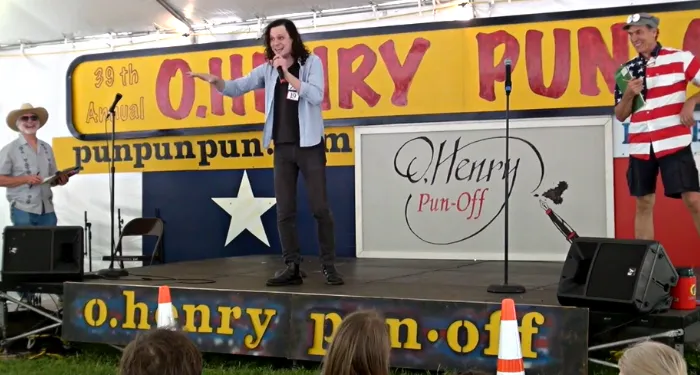
O. What Fun: A History of the O. Henry Pun-Off World Championships
It’s the most punderful time of the year! Across the nation, punthusiasts are prepping their best jokes for the O. Henry Museum Pun-Off World Championships, an annual pun-off every May. Started in 1978, the competition is run by a P.U.N.Y group (AKA “Punsters United Nearly Yearly”) that ranks contestants’ puns from 1-10 as well as elects a “most viable punster” each year. The gathering draws fans of witty wordplay to Austin, Texas, where 64 of America’s most gifted punsters will match wits with one another in both scripted and off-the-cuff competitions.
The contest takes place at the O. Henry Museum, in Austin, Texas, which honors the life and work of William Sidney Porter, AKA the famed writer O. Henry. Primarily famous for his short stories, O. Henry authored well-known works like “The Gift of the Magi” and “The Ransom of Red Chief” as well as poems and newspaper articles. O. Henry’s work quickly spread through the newspapers and serials of the day, and though most readers might associate him with his short stories, he also was known for his humor and, for a time, managed a satirical paper called “The Rolling Stone”. The building that now houses the museum was originally his home in Austin and where he wrote some of his earliest stories. In addition to hosting the pun-off, it also preserves many of the author’s artifacts and writing tools from his career.
When this year’s competition is held on May 13th, puntestants will choose to compete in one of two categories: Punniest of Show or Punslingers. Punniest of Show participants prepare 90-second pieces ahead of time to impress the judges with their best. These pieces might include props, music, or other staging, and the top three scorers are awarded prizes. Punslingers, on the other hand, compete in improv style with no prior rehearsal. Competitors in this category are paired up and given a topic, and then have five seconds to deliver a pun, going back and forth until one of the pair is eliminated and the other moves on to the next round, with the winner being the last person standing. Both contests are full of creativity, wordplay, and side-splitting laughter (and occasional groans).
According to Pun-Off founders Steve Uzzell and Joel McColl, the roots of the event came from the 1978 Pecan Street Festival where a group of friends, including the two men, found themselves drinking beer and swapping stories in the museum’s backyard. As the stories became increasingly outlandish, and increasingly likely to end in puns, Uzzell declared that the group should meet up to honor the occasion each year, and the Pun-Off was born. The early years of the Pun-Off were marked by beer, rowdy spectators, and an ever-escalating quest to go over the top: longform contests wore costumes, performers created their own props, and one man even performed standing on his head. As the occasion grew, it became an official, unofficial, part of the Austin social calendar, and the city began to take notice. In 1989, the city of Austin moved to officially take over the festival, despite the protestations of its original organizers, leading the city to sue the founders and eventually win the right to host the Pun-Off as an official city event. Though Uzzell and McColl were disappointed, Uzzell did return to help emcee the event in the 1990s.
McColl attributes the longrunning success of the Pun-Off to the fact that it’s both entertainment and competition, a fun show of wordplay that is as enjoyable for those participating as it is for spectators. Past winning puns have ranged from 2016 winner Jerzy Gwiazdowski’s countries-of-the-world-themed entry in the Punniest of Show category, to a periodic table of elements themed round in the Punslingers division.
The competition rewards those who can think on their feet, as well as linguists with a sense of how to manipulate words and a flair for the dramatic. Puns themselves are an art form within language and the best Pun-Off contestants are skilled at finding the weak spots in a sentence where a double-meaning or homonym can be inserted to make a pun. Year after year, the faithful flock to Austin to explore what producer Gary Hallock has termed “terrorism” in the form of wordplay and Wired writer Peter Rubin described as “the linguistic thunderdome”, rejoicing in being around others who share the fun of puns.








